The Law, Defences and Penalties for Torture in Australia

The Brisbane Supreme Court has heard a chilling account of the final moments of Queensland couple Iuliana Triscaru and Cory Breton, whose decomposed bodies were found in a toolbox – weighed down with blocks and tyres – after it was pulled from a lagoon at Scrubby Creek, south of Brisbane, in 2016.
The court has heard that Iuliana Triscaru and Cory Breton, who were drug dealers, were lured to a unit where they were assaulted and tied up.
They were loaded into a large toolbox and placed on the back of a Toyota Hilux, where they were kept for several hours before being dumped into the creek. A Coroner told the court it is likely the pair drowned, although the cause of death could have been asphyxiation.
Witnesses have told the court that the couple were beaten and their screams and pleas could be heard from inside the toolbox.
Details of the final hours preceding the couple’s death have been presented as evidence in the case, in which several men, Trent Michael Thrupp, Davy Malu Junior Taiao, Stou Daniels and Waylon Ngaketo Cowan Walker have each pleaded not guilty to two counts of murder.
Last year, another man, Tuhirangi-Thomas Tahiata was found guilty of two counts of murder, was given two life sentences. He is ineligible to apply for parole until 2046.
Three of the men currently on trial, Mr Taiao and Mr Thrupp and Mr Daniels have also each been charged with two counts of torture.
The offence of torture in Queensland
Section 320A of Queensland’s Criminal Code 1899 prescribes a maximum penalty of 14 years in prison for intentionally inflicting severe pain or suffering on a person by an act or series of acts.
“Pain or suffering” includes physical, mental, psychological or emotional pain or suffering, whether temporary or permanent.
New South Wales
There is no specific offence of torture in New South Wales. However, there are a range of assault offences which may encompass such conduct, ranging from common assault to intentionally inflicting grievous bodily harm, the latter attracting a maximum penalty of 25 years in prison.
Commonwealth torture offences
In addition to this, the Commonwealth Criminal Code Act 1995 – which applies across Australia – contains offences of torture where the conduct:
- Is committed by a public official or a person acting in the capacity of a public official,
- Is committed during the course of international armed conflict,
- Is committed during the course of national armed conflict, or
- Amounts to a crime against humanity.
Torture by public official
Section 274.2 of the Criminal Code Act 1995 (Cth) prescribes a maximum penalty of 20 years in prison for any person who engages in conduct that inflicts severe physical or mental pain or suffering on a person (the victim), and:
- The conduct is engaged in:
- for the purpose of obtaining from the victim or from a third person information or a confession; or
- for the purpose of punishing the victim for an act which the victim or a third person has committed or is suspected of having committed; or
- for the purpose of intimidating or coercing the victim or a third person; or
- for a purpose related to a purpose mentioned above; and
- the perpetrator engages in the conduct:
- in the capacity of a public official; or
- acting in an official capacity; or
- acting at the instigation, or with the consent or acquiescence, of a public official or other person acting in an official capacity.
The section prescribes the same maximum penalty where a person:
- engages in conduct that inflicts severe physical or mental pain or suffering on a person; and
- the conduct is engaged in for any reason based on discrimination of any kind; and
- the person engages in the conduct:
- in the capacity of a public official; or
- acting in an official capacity; or
- acting at the instigation, or with the consent or acquiescence, of a public official or other person acting in an official capacity.
International war crime of torture
Section 268.25 of the Criminal Code Act prescribes a maximum penalty of 25 years in prison for any person who:
- inflicts severe physical or mental pain or suffering upon one or more persons; and
- the perpetrator inflicts the pain or suffering for the purpose of:
- obtaining information or a confession; or
- a punishment, intimidation or coercion; or
- a reason based on discrimination of any kind; and
- the person or persons are protected under one or more of the Geneva Conventions or under Protocol I to the Geneva Conventions; and
- the perpetrator knows of, or is reckless as to, the factual circumstances that establish that the person or persons are so protected; and
- the perpetrator’s conduct takes place in the context of, and is associated with, an international armed conflict.
National war crime of torture
Section 268.73 of the Criminal Code Act prescribes a maximum penalty of 25 years in prison for any person who:
- inflicts severe physical or mental pain or suffering upon one or more persons; and
- the perpetrator inflicts the pain or suffering for the purpose of:
- obtaining information or a confession; or
- a punishment, intimidation or coercion; or
- a reason based on discrimination of any kind; and
- the person or persons are not taking an active part in the hostilities; and
- the perpetrator knows of, or is reckless as to, the factual circumstances establishing that the person or persons are not taking an active part in the hostilities; and
- the perpetrator’s conduct takes place in the context of, and is associated with, an armed conflict that is not an international armed conflict.
Crime against humanity of torture
Section 268.13 of the Criminal Code Act prescribes a maximum penalty of 25 years in prison for any person who:
- inflicts severe physical or mental pain or suffering upon one or more persons who are in the custody or under the control of the perpetrator; and
- the pain or suffering does not arise only from, and is not inherent in or incidental to, lawful sanctions; and
- the perpetrator’s conduct is committed intentionally or knowingly as part of a widespread or systematic attack directed against a civilian population.
Defences to torture offences
Legal defences to torture offences include:
- Self-defence,
- Duress, and
- Necessity.
Where evidence is raised of any such defence, the prosecution is then required to negative (disprove) that defence beyond a reasonable doubt.
The accused person is entitled to an acquittal (a finding of not guilty) if the prosecution is unable to do this.








